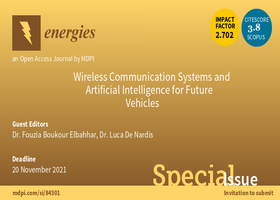Wireless Communication Systems and Artificial Intelligence for Future Vehicles
A special issue of Energies (ISSN 1996-1073). This special issue belongs to the section "B2: Clean Energy".
Deadline for manuscript submissions: closed (20 November 2021) | Viewed by 5347

Special Issue Editors
Interests: 5G; cognitive radios; wireless communications; indoor localization; transport systems; V2X communication
Special Issues, Collections and Topics in MDPI journals
Special Issue Information
Dear Colleagues,
The open access journal Energies (IF: 2.702, ISSN 1996-1073) is pleased to announce the launch of a new Special Issue entitled “Wireless Communication Systems and Artificial Intelligence for Future Vehicles”. We are serving as Guest Editors for this issue.
Context
Communication V2X plays a significant role in improving road safety and optimizing traffic management. Wireless communication allows sharing a large amount of data collected from hundreds of embedded sensors, encompassing all the communications between a vehicle and its environment.
Beyond the need for high data rates for V2X communication—which has been the main driver of wireless network evolution in the past decade—next-generation V2X wireless communication must be able to deliver excellent reliability, energy autonomy, good quality-of-service (QoS), and low-latency in communication, that is adaptive, in real-time, for dynamic communication systems. These requirements mandate a fundamental change in the way in which wireless networks are studied, modeled, designed, and optimized.
While the main ingredients for 5G and beyond—such as dense small cell deployments, millimeter wave (mmWave) communications, beamforming, and device-to-device (D2D) communications—have been proposed, integrating them into a truly harmonious wireless system that can address the challenges in V2X communication requires instilling intelligent functions across all steps of wireless communication. These intelligent functions can only be realized by integrating fundamental notions of artificial intelligence (AI) across the wireless infrastructure and end-user devices. In fact, artificial intelligence (AI) approaches well known from computer science disciplines are beginning to emerge in wireless communications. These AI approaches have been first widely applied to the upper layers of wireless communication systems. These designed system models and algorithms greatly improve the performance of V2X communication systems based on traditional algorithms. Due to the new features of future V2X communications, such as multitude services with unknown channel models, high-speed and accurate processing requirements, complicated heterogeneous networks, and limited spectral and frequency resources, traditional solutions are no longer suitable. Therefore, AI will become the best solution for assuring that the requirements of V2X wireless communication for future vehicles are met.
The main focus of this Special Issue is the research challenges relating to the new generation of V2X communication and AI’s contribution to improving the performance of these communications.
Dr. Fouzia Boukour Elbahhar
Dr. Luca De Nardis
Guest Editors
Manuscript Submission Information
Manuscripts should be submitted online at www.mdpi.com by registering and logging in to this website. Once you are registered, click here to go to the submission form. Manuscripts can be submitted until the deadline. All submissions that pass pre-check are peer-reviewed. Accepted papers will be published continuously in the journal (as soon as accepted) and will be listed together on the special issue website. Research articles, review articles as well as short communications are invited. For planned papers, a title and short abstract (about 100 words) can be sent to the Editorial Office for announcement on this website.
Submitted manuscripts should not have been published previously, nor be under consideration for publication elsewhere (except conference proceedings papers). All manuscripts are thoroughly refereed through a single-blind peer-review process. A guide for authors and other relevant information for submission of manuscripts is available on the Instructions for Authors page. Energies is an international peer-reviewed open access semimonthly journal published by MDPI.
Please visit the Instructions for Authors page before submitting a manuscript. The Article Processing Charge (APC) for publication in this open access journal is 2600 CHF (Swiss Francs). Submitted papers should be well formatted and use good English. Authors may use MDPI's English editing service prior to publication or during author revisions.
Keywords
- V2X wireless communications
- AI and channel propagation
- Physical layer for V2X communication
- AI and future vehicles
- D2D and AI
Benefits of Publishing in a Special Issue
- Ease of navigation: Grouping papers by topic helps scholars navigate broad scope journals more efficiently.
- Greater discoverability: Special Issues support the reach and impact of scientific research. Articles in Special Issues are more discoverable and cited more frequently.
- Expansion of research network: Special Issues facilitate connections among authors, fostering scientific collaborations.
- External promotion: Articles in Special Issues are often promoted through the journal's social media, increasing their visibility.
- e-Book format: Special Issues with more than 10 articles can be published as dedicated e-books, ensuring wide and rapid dissemination.
Further information on MDPI's Special Issue polices can be found here.






